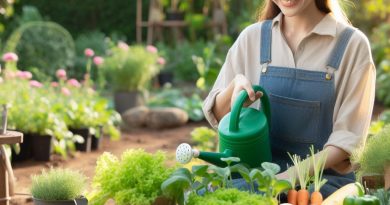Gardening Tools: Must-Haves for Beginners
Last Updated on March 2, 2024
Introduction
Having the right gardening tools is essential for beginners as it significantly impacts the success of their gardening journey.
In this blog section, we will discuss the must-have gardening tools that every beginner should consider in order to achieve their gardening goals.
These tools play a crucial role in simplifying tasks and ensuring the health and growth of plants.
Let’s delve into the brief overview of the essential gardening tools we will cover.
- Gloves: Protecting your hands is important while gardening, and a good pair of gloves provides safety.
- Trowel: This handheld tool with a narrow blade is perfect for digging small holes and transplanting.
- Pruners: Pruning shears or secateurs help in cutting branches, promoting healthy growth, and maintaining shape.
- Watering Can: Proper watering is vital, and a watering can allows controlled and precise watering of plants.
- Shovel: This tool is essential for digging large holes, moving soil, or planting in bulk.
- Rake: Used for leveling the soil, removing debris, and preparing the ground for planting.
- Garden Hoe: A versatile tool for weeding, breaking up soil, and creating planting rows.
- Wheelbarrow: Ideal for transporting heavy objects, such as plants, soil, or tools, around the garden.
- Garden Fork: This tool helps in aerating the soil, turning compost, and loosening stubborn clumps.
- Cultivator: Perfect for breaking up soil, removing weeds, and mixing in fertilizers or compost.
By understanding the importance of these essential gardening tools and their specific uses, beginners can equip themselves with the right tools and lay a solid foundation for a successful gardening experience.
Basic Hand Tools
When it comes to gardening, having the right tools is essential for beginners.
Here are some basic hand tools that every gardener should have:
Trowel: Essential for Planting
A trowel is a small handheld tool with a pointed blade used for digging small holes, transplanting seedlings, and planting bulbs.
It is a must-have for any beginner gardener.
To use a trowel, hold it firmly and dig a hole in the soil, making sure it is deep enough for the plant’s roots.
Gently place the plant in the hole and cover it with soil, pressing firmly around the base.
Garden Fork: Loosening Soil
A garden fork is a tool with four sturdy tines, which is used for loosening compacted soil, aerating the ground, and turning over the topsoil.
The benefits of using a garden fork are numerous. It breaks up hard clumps of soil, allowing for better drainage and root penetration.
It also helps in mixing organic matter or fertilizer evenly throughout the soil.
Pruning Shears: Keeping Plants Healthy
Pruning shears, also known as secateurs, are used for trimming and cutting plants.
Regular pruning promotes plant health and encourages growth.
It is important to trim dead branches, remove diseased parts, and shape the plants to improve their overall appearance.
Use sharp pruning shears and make clean cuts just above leaf nodes or growth buds.
Weeder: Bye-Bye Weeds
A weeder is a handy tool that helps in efficiently removing weeds from the garden.
Weeds compete with plants for nutrients, water, and sunlight.
Using a weeder, you can dig into the soil and carefully remove the entire weed, including its roots.
This prevents the weed from growing back and ensures a weed-free garden.
Hand Gloves: Protection First
Wearing hand gloves is essential for protecting your hands while gardening.
It prevents blisters, cuts, and contact with harmful substances.
Gloves also provide a better grip on tools, reducing the risk of accidental slips or injuries.
Choose gloves made of durable and breathable material for maximum comfort and protection.
These basic hand tools are a great starting point for beginners in gardening.
They will make your gardening tasks easier, more enjoyable, and help you achieve healthier plants and a thriving garden.
Read: Sustainable Practices for Small Farms
Essential Digging Tools
When it comes to gardening, having the right tools is essential for success.
Among the various tools that beginners should invest in, digging tools are particularly important.
These tools help with tasks such as planting, clearing debris, and creating defined borders.
Let’s explore the different types of essential digging tools and their uses in the garden.
Shovel
The shovel is a versatile tool with various types that serve different purposes.
A garden spade shovel is excellent for digging planting holes, while a round-point shovel is ideal for moving soil or compost.
A trenching shovel, with its narrow blade, is great for creating trenches or edging flower beds.
Each type of shovel plays a vital role in different garden tasks.
Garden hoe
A garden hoe is a must-have tool for any gardener.
It is designed to break up soil and remove weeds.
By using a hoe, you can easily cultivate the soil, ensuring proper aeration for your plants.
There are different variations of hoes, including the draw hoe, scuffle hoe, and Warren hoe.
Each type is suited for specific gardening tasks and soil conditions.
Rake
The rake is a tool that offers several benefits in the garden.
It is primarily used for leveling soil, removing debris, and spreading mulch.
Raking allows for a smooth and even surface, promoting better seed germination and preventing water pooling.
There are different types of rakes available, such as leaf rakes, garden rakes, and landscape rakes, each serving a particular purpose.
Spade
A spade is a sharp-edged tool that is incredibly useful for digging holes and edging.
Its blade easily cuts through soil and roots, making it perfect for various garden tasks.
Whether you need to transplant a plant, remove sod, or create clean edges around flower beds, a spade is an essential tool to have on hand.
Edger
Edging tools, such as an edging spade or half-moon edger, play a crucial role in creating neat borders in your garden.
They define the space between your lawn and flower beds, preventing grass from growing into your planting areas.
Edging also gives your garden a clean and professional-looking finish.
Using an edger ensures that your garden beds remain well-defined and visually appealing.
In short, having the right digging tools is essential for any gardener, especially beginners.
A shovel, garden hoe, rake, spade, and edger are must-haves for various garden tasks.
They facilitate planting, weed removal, soil leveling, and edging, ensuring a successful and visually appealing garden.
So, equip yourself with these essential digging tools and watch your garden thrive.
Happy gardening!
Read: Container Gardening: Ideal for Small Areas

Watering Tools
Watering is an essential task in maintaining a healthy garden.
Here are some must-have watering tools for beginners:
Watering Can: Advantages of Using a Watering Can for Gentle Watering
A watering can is a classic and versatile tool that allows for controlled and precise watering.
Its advantages include:
- Easy to use and maneuver, especially in tight spaces or around delicate plants.
- Provides a gentle flow of water, preventing soil erosion and avoiding damage to young sprouts.
- Allows for targeted watering, ensuring that the water reaches the plant’s root system.
- Can be filled with nutrient-rich water or diluted fertilizer for direct application to plants.
Hose and Spray Nozzle: Benefits of Using a Hose and Spray Nozzle for Larger Areas
For watering larger areas or gardens, a hose with a spray nozzle is ideal.
Here’s why:
- Covers a wider area, saving time and effort compared to using a watering can.
- The spray nozzle provides different settings, allowing for adjustable water pressure and patterns.
- Enables watering from a distance, making it easier to reach plants in elevated containers or hanging baskets.
- Can be attached to a sprinkler or connected to other watering tools for added convenience.
Sprinklers: Overview of Different Types of Sprinklers for Watering the Garden Efficiently
Sprinklers are perfect for irrigating larger areas or lawns. Here are some common types:
- Rotating Sprinklers: Rotate and distribute water in a circular pattern, covering a large area.
- Oscillating Sprinklers: Move back and forth, providing even coverage to rectangular or square spaces.
- Impact Sprinklers: Emit water in a pulsating motion, making them suitable for large yards or irregularly shaped areas.
- Drip Irrigation: Delivers water directly to the plant’s root zone while minimizing water loss through evaporation or runoff.
Water Timer: Benefits of Using a Timer to Control Watering Frequency
A water timer is a helpful tool for ensuring consistent and efficient watering. Its advantages include:
- Automates the watering process, allowing you to set specific schedules and durations.
- Prevents overwatering by regulating the amount of water your garden receives.
- Helps conserve water by avoiding unnecessary wastage or forgetting to turn off the water source.
- Useful for gardeners with busy schedules or those who may be away for extended periods.
Rain Barrel: Explanation of Rain Barrels and How They Conserve Water
A rain barrel is a great eco-friendly tool that collects and stores rainwater for later use. Its benefits include:
- Reduces reliance on tap water, saving on water bills and promoting sustainability.
- Provides a natural water source free from chemicals, which is beneficial for plant growth.
- Helps prevent soil erosion and stormwater runoff, mitigating environmental pollution.
- Contributes to water conservation during droughts or dry periods.
Investing in the right watering tools is essential for any beginner gardener.
Whether it’s a simple watering can or a more sophisticated system, these tools will help you keep your plants healthy and thriving.
Read: Beekeeping: Boosting Your Garden’s Health
Protective Gear
When it comes to gardening, it’s important to prioritize your safety and well-being.
Using the right protective gear can make all the difference in preventing accidents and ensuring a comfortable gardening experience.
In this section, we will discuss the must-have protective gear for beginners.
Garden Hat: Importance of Protecting Oneself from the Sun
One essential piece of protective gear is a garden hat.
The sun can be harsh, and prolonged exposure can lead to sunburns, heatstroke, and even skin cancer.
Wearing a garden hat provides shade and protects your face and neck from harmful UV rays. Plus, it’s a stylish accessory!
Safety Goggles: Reasons for Wearing Goggles While Using Power Tools or Handling Chemicals
Another crucial protective gear to consider is safety goggles.
When working with power tools or handling chemicals, there’s always a risk of debris, sparks, or splashing substances getting into your eyes.
Wearing safety goggles provides a barrier and ensures your eyes’ safety from potential harm.
Knee Pads: Benefits of Using Knee Pads for Comfort During Extended Periods of Kneeling
Gardening often involves spending long hours kneeling or working close to the ground.
This can put a strain on your knees and cause discomfort or even injury.
Investing in knee pads provides cushioning and support, allowing you to garden with ease and comfort.
Your knees will thank you!
Garden Apron: Why Wearing an Apron with Multiple Pockets is Practical
A garden apron with multiple pockets is a practical and convenient accessory for any gardener.
It allows you to keep your tools, seeds, and other essentials within easy reach.
You won’t need to constantly search for what you need, saving you time and effort.
Stay organized and efficient with a garden apron!
Sunscreen and Insect Repellent: Reminders to Protect Against Harmful UV Rays and Bugs
Lastly, never underestimate the importance of protecting your skin from the sun and pesky insects.
Applying sunscreen with a high SPF will shield your skin from harmful UV rays and reduce the risk of sunburns and skin damage.
Additionally, wearing insect repellent will keep those annoying bugs at bay, protecting you from bites and potential diseases.
In essence, investing in protective gear is essential for any beginner gardener.
A garden hat, safety goggles, knee pads, garden apron, sunscreen, and insect repellent are the must-haves that will ensure your safety, comfort, and enjoyment while tending to your garden.
Don’t forget to prioritize your well-being and have a safe gardening experience!
Read: Farm-to-Table: Growing Your Own Food
Delve into the Subject: Herbs & Greens: Hydroponic Gardening Easy
Storage and Maintenance
In order to take proper care of your gardening tools and ensure their longevity, it is essential to have a dedicated storage area and follow regular maintenance practices.
Here are some important aspects to consider:
Garden Shed: Importance of Having a Dedicated Storage Area for Tools
A garden shed serves as an excellent storage solution for your gardening tools.
It helps keep your tools organized, protected from the elements, and easily accessible whenever you need them.
Having a dedicated space for your tools also reduces the chances of misplacing or losing them.
Tool Rack/Organizer: Benefits of Using a Rack/Organizer to Keep Tools Accessible and in Good Condition
Investing in a tool rack or organizer is a smart choice for any beginner gardener.
It provides a convenient way to store your tools vertically, saving space and keeping them within reach.
Additionally, a rack/organizer helps maintain proper tool alignment, preventing damage and prolonging their usability.
Cleaning and Maintenance Tips: Proper Cleaning and Maintenance Practices to Prolong the Life of Gardening Tools
Regular cleaning and maintenance are crucial to ensure your gardening tools remain functional and last for years to come.
Here are some essential tips:
- After each use, remove dirt, debris, and moisture from your tools using a brush or cloth.
- Make sure to dry them thoroughly to prevent rust and corrosion.
- Apply a light coat of oil on metal parts to inhibit rust formation.
- Inspect handles for any cracks or splinters regularly and repair or replace them when needed.
Sharpening Tools: Brief Explanation of How to Sharpen Various Gardening Tools
Over time, gardening tools can become dull and ineffective. Learning how to sharpen them is a valuable skill.
Here are some common tools and the sharpening methods associated with them
- Secateurs/Pruners: Use a sharpening stone or a whetstone to sharpen the blade at a 20-degree angle.
- Shears/Hedge Trimmers: File the edges of the blades using a mill file or sharpening stone.
- Lawn Mower Blades: Remove the blades and sharpen them carefully with a file or grinder.
- Spades/Shovels: Use a file or grinder to sharpen the blade while maintaining its original bevel angle.
Winter Storage: Recommendations for Storing Tools During the Winter Months
During the winter, when gardening activities slow down, it is essential to store your tools properly to prevent damage.
Here are some recommendations
- Clean and dry your tools thoroughly before storing them to avoid rust and corrosion.
- Apply oil or use a rust inhibitor on metal parts for added protection.
- Store tools in a dry area with low humidity to prevent moisture damage.
- Hang tools on racks or hooks to keep them off the ground and prevent unnecessary strain on handles.
By following these storage and maintenance practices, you can ensure that your gardening tools remain in excellent condition, making your gardening tasks easier and more enjoyable.
You Might Also Like: Top 10 Must-Have Garden Tools for Beginners
Conclusion
To recap, the must-have gardening tools for beginners include a trowel, pruners, gloves, a watering can, and a rake.
These tools will make your gardening journey easier and more enjoyable.
I encourage you to invest in these tools to ensure a successful gardening experience.
It is essential to always choose high-quality gardening tools.
This will not only provide better results but also ensure their long-term use.
Proper care and maintenance are crucial, so make sure to clean and store them properly after each use.
Remember, well-maintained tools will last for years.
By having the necessary gardening tools, you will be equipped to tackle any gardening task.
Whether you are planting flowers, vegetables, or herbs, these tools will help you achieve your desired results.
So, don’t hesitate to invest in them.
Gardening is not only a hobby but also a fulfilling experience.
It allows you to connect with nature and enjoy the beauty of your outdoor space.
With the right tools, you can take your gardening skills to the next level and create a stunning garden.
So, what are you waiting for? Purchase these must-have gardening tools and start your gardening journey today.
Embrace the joy of gardening and witness the wonders it brings to your life and surroundings.
Happy gardening!


